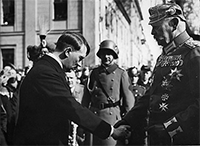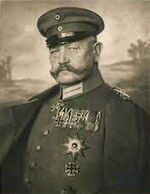The government that Hitler and Ludendorff and others were trying to overthrow was the Weimar Republic, the representative government that had replaced the autocratic German Empire, at the end of the First As was the case with many world leaders, Hindenburg proved unable to maintain public confidence in the governments or its ability to solve the economic crisis brought on by the Great Depression. Unemploymenet skyrocketed, as did public discontent. Into this void stepped the Nazi Party. Hitler had served only nine months in prison for his role in the Beer Hall Putsch and found himself released in late December 1924. He went to work building up the influence-making apparatus of the Nazi Party. The Bavarian government had acted to blunt Hitler's influence, not only by having the Nazi Party banned but also by trying to have Hitler deported, to Austria. Neither stratagem was successful, and Hitler and his party were in prime position to capitalize on the severe discontent that gripped Germany when the global economy collapsed. The National Socialists promised job creation, economic security, and an outright denunciation of the Treaty of Versailles. Capitalizing on the assistance of business Alfred Hugenberg and others, Hitler and the NSDAP expanded their message. By 1930, the party had representation well beyond its base in Bavaria. From having 12 seats in the Reichstag (lower house) in 1928 to having 107 seats in 1930, the National Socialists gained in power and, in the eyes of a great many, legitimacy. Economically and politically dispossessed people in other parts of the country rallied to the Nazi cause. Hitler ran for President against Hindenburg in March 1932. No candidate got a majority and so the election proceeded to a runoff. Hindenburg garnered 49 percent of the vote in the first round, with Hitler getting 30 percent. Hitler improved to 37 percent in the runoff, but Hindenburg's 53 percent was enough to secure him re-election. Hitler was a candidate for President in the July 1932 election; he did not win, but his party swelled to a membership of 230 seats in the Reichstag. They did not have a majority, but they had a large voice. Then-Chancellor Franz von Papen called for yet another election, in November; the result was the same. 
President Hindenburg named Hitler as Chancellor on Jan. 30, 1933. Less than a month later was the Reichstag fire. Hitler convinced Hindenburg to sign the Fire Decree, suspending civil liberties throughout the country. In new elections, the Nazi Party won a majority. Soon, the new government had passed the Enabling Act, removing lawmaking powers from the Reichstag and giving them to the top-level government. As well, all political parties but the Nazi Party were banned; prohibited as well were labor unions. The national government took over running of the states. |
|
Social Studies for Kids
copyright 2002–2025
David White



 Then, in Munich in 1923 was the Beer Hall Putsch, an attempt by Hitler and other members of the NSDAP to take over the government. The coup attempt failed, and Hitler and war hero Erich Ludendorff were among those arrested; the former was convicted and sent to prison, and the latter was acquitted after claiming that he was an accidental participant. During his time in prison, Hitler wrote his famous autobiographical manifesto Mein Kampf (My Struggle), which contained many of the ideas that later formed governmental policy in Nazi Germany.
Then, in Munich in 1923 was the Beer Hall Putsch, an attempt by Hitler and other members of the NSDAP to take over the government. The coup attempt failed, and Hitler and war hero Erich Ludendorff were among those arrested; the former was convicted and sent to prison, and the latter was acquitted after claiming that he was an accidental participant. During his time in prison, Hitler wrote his famous autobiographical manifesto Mein Kampf (My Struggle), which contained many of the ideas that later formed governmental policy in Nazi Germany. World War. The President of the Weimar Republic since it began was
World War. The President of the Weimar Republic since it began was 
